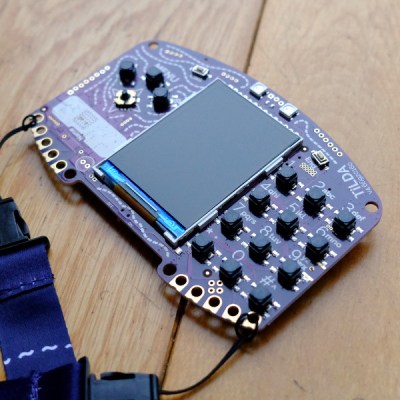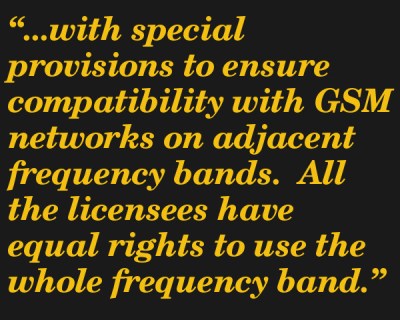The Electromagnetic Field 2018 hacker camp in the UK will have its own GSM phone network, and as we have already covered its badge will be a fully-functional GSM phone. This is as far as we are aware a first in the world of badges, and though it may not be a first in hacker camp connectivity it is still no mean achievement at the base station side. To find out more we talked to two of the people behind the network, on the radio side Lime Microsystems‘ [Andrew Back], and on the network side Nexmo‘s developer advocate, [Sam Machin].
There are sixteen base stations spread around the site, of which each one is a Raspberry Pi 3 B+ with a LimeSDR Mini. Development of the system was undertaken prior to the release of the Raspberry Pi Foundation’s PoE board, so they take a separate 24V supply which powers the Pi through a DC-to-DC converter. This arrangement allows for a significant voltage drop should any long cable runs be required.
On the software side the base stations all run the Osmocom (Open Source Mobile Communications) cellular base station infrastructure package. It was a fine decision between the all-in-one Osmocom NITB package and the fully modular Osmocom, going for the former for its reliability. It was commented that this would not necessarily be the case at a future event but that it made sense in the present. It appears on the network as a SIP phone system, meaning that it can easily integrate with the existing DECT network. Let’s take a look at how the network operates from the user side, and the licencing loophole that makes everything possible.
Phone Numbers and Vanity Numbers
As a user, you will find a SIM card along with your badge, from the IoT connectivity provider Hologram. This is a fully-functional SIM for public networks, however it serves simply for access to the event network and no Hologram sign-up is required on-site. We are told that the network doesn’t implement the SIM-based encryption of the commercial networks so in theory any SIM would work at the network level, however the supplied batch of Hologram SIMs is manageable enough in size that they are individually authorised on the network.

Users will receive a 5-digit number, however you can register your choice of a 4-digit number with the “Phonebook of Electromagnetic Field 2018” (known as Eventphone) and tie it to your GSM number. For Hackaday, we’ve registered 4096. We are told there will be an outgoing connection providing free calls to the UK, US, and Europe, and there will be incoming access via a gateway number. There will also be a range of special numbers for such matters as audio feeds and other on-site facilities, and they hope to have the Jasmin SMS-to-HTTP gateway running to provide a hackable interface for apps using the badge. There is no GSM data connectivity, as any data can be channeled more effectively through the on-site wireless network. Each base station only has capacity for 7 calls simultaneously, and since GSM data streams take calling channels there would very quickly be no voice bandwidth available were data to be enabled. It will be interesting to see if anyone hacks together their own cell data system during camp!
Licencing the Spectrum
Perhaps the most interesting background story surrounding the network comes from the way it is licensed. Anyone capable of setting up Osmocom can create a GSM network of their own, but for an event such as Electromagnetic Field it must be an officially sanctioned affair to avoid all concerned getting into trouble with the law.
 After a few mergers in the cellular phone industry there are four main British network providers, and securing a network licence can be an extremely costly affair with price tags running into the billions. Over the years some quirks have appeared in the system as an unintended consequence of different political regimes administering it. One of the most useful quirks is the so-called concurrent network access licences. These are a special class of low-power licence in the 1800 MHz range in an allocation originally left empty as a guard band between GSM and DECT allocations. Whereas other cellular licenced frequency rages are exclusive to the operator that holds them, this one is shared across a number of licencees using it concurrently. There are a number of licence holders, including small some unexpected small players as well as the big ones, and it is one of these companies that has rented its licence to the event.
After a few mergers in the cellular phone industry there are four main British network providers, and securing a network licence can be an extremely costly affair with price tags running into the billions. Over the years some quirks have appeared in the system as an unintended consequence of different political regimes administering it. One of the most useful quirks is the so-called concurrent network access licences. These are a special class of low-power licence in the 1800 MHz range in an allocation originally left empty as a guard band between GSM and DECT allocations. Whereas other cellular licenced frequency rages are exclusive to the operator that holds them, this one is shared across a number of licencees using it concurrently. There are a number of licence holders, including small some unexpected small players as well as the big ones, and it is one of these companies that has rented its licence to the event.
The Surprising Simplicity of a Complex Network
We’re impressed with this network, with the relative simplicity of its hardware implementation, the useful functionality it will provide, and the way they have secured a licence for it. We know that like all the systems at a hacker camp a lot of work has gone into it, and on behalf of all attendees we’d like to thank all concerned for making it happen. We look forward to seeing what you will all do with it.
















So, they all say “Base Station”.
Will there be a Base Base Station to rule them all?
Or would that be a “Base Station Base”? Hmmmm….
In GSM, the terms would be “Base Transceiver Station” for the tower, “Base Station Controller” for the center between multiple base stations in an area, and “Mobile Switching Centre” for the even higher level center connecting phone calls: https://en.wikipedia.org/wiki/GSM#/media/File:Gsm_structures.svg
All your base station…
Hey, the LimeSDR! I have one of those. It’s nice to see it on here again.
Why not 4225?
or 1337. possibilities are endless.
1337 is just lame…
Well they probably didn’t allow 5 numbers so they wouldn’t have attendees fighting over 58008!
“possibilities are endless.”
No, I’m pretty sure the possibilities are limited to 10000…
B^)
Less than 10,000, since some are taken. If there’s a prefix used for outgoing calls, it would only be 9000.
1234 so it matches my password.
And my luggage!
and my axe!
I have know idea if that is some cultural reference, but I found it funny anyway!
Don’t know about the axe, but 1234 on luggage is from spaceballs
https://knowyourmeme.com/memes/you-have-my-sword-and-my-bow-and-my-axe
Looking forward to my chance to play with this tomorrow.
Already planning to add wireless charging.
Interesting, but I’m left with the following. Most likely most attending already have a mobile phones. IMO all this does is raise the cost of holding the event with little value added. I’d be more impressed if it was a system for the exclusive use of registered attendees, using license free spectrum.
Well it is, as the only the supplied SIM cards are accepted to the network. So it is not exactly public.
Some homebrew 868MHz+2400MHz TDMA TDD digital voice phone system would be wild.
But they already do have a DECT network on the license free 1890MHz european DECT band.
200mW on a dedicated band is way better anything 2400MHz would be capable of.
“cellular licenced frequency rages” sound interesting.
I’m sure it is just a carry over from automobile “traffic”.
The ninjas setup a base station in 2011 at def con. The badges we’re Google because ones.